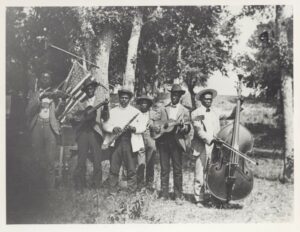
Stephenson, Mrs. Charles (Grace Murray). [Emancipation Day Celebration band, June 19, 1900], photograph, June 19, 1900; University of North Texas Libraries, The Portal to Texas History, https://texashistory.unt.edu; crediting Austin History Center, Austin Public Library.
Juneteenth originated in Texas and with that, the foods eaten during this celebration have a strong history in the South.
According to Culinary Historian, Michael W. Twitty:
After slavery enslaved people began to recall and re-construct their experience through the celebration of Juneteenth. The practice of eating red foods—red cake, barbecue, punch and fruit– may owe its existence to the enslaved Yoruba and Kongo brought to Texas in the 19th century. For both of these cultures the color red is the embodiment of spiritual power and transformation. Enslavement narratives from Texas recall an African ancestor being lured using red flannel cloth, and many of the charms and power objects used to manipulate invisible forces required a red handkerchief. It’s clear that even in slavery’s aftermath; Afro-Texans had a rich food culture, created under adversity in communities with rich cultural origins and a diversity of influences, with a strong root in the foodways and cultures of West and Central Africa.
More on red foods:
Red foods are customary for Juneteenth, the crimson a symbol of ingenuity and resilience in bondage. Watermelon, Texas Pete hot sauce and red velvet cake are abundant. A strawberry pie wouldn’t be out of place. Spicy hot links on the grill — most commonly made with coarsely ground beef, and artificially dyed red — are a Juneteenth staple, too, and ”a distinctive African-American contribution to barbecue,” said Adrian Miller, a James Beard award-winning author and soul food expert.
Red drinks, like strawberry soda and Texas-made Big Red pop, generally rule the Juneteenth bar, and link present to past. ”Two traditional drinks from West Africa that had a lot of social meaning are kola nut tea and bissap,” Mr. Miller said. (Bissap is more commonly known as hibiscus tea.) Both came to the Americas with the slave trade; red kola nuts and hibiscus pods colored the water in which they were steeped.
Taylor, Nicole. “Hot Links and Red Drinks: A Juneteenth Tradition.” New York Times, 14 June 2017, p. D3(L). Gale OneFile: News, link.gale.com/apps/doc/A495524718/STND?u=maine&sid=bookmark-STND&xid=948834f4. Accessed 20 June 2024.
posted: , by Raminta Moore